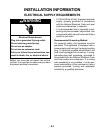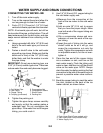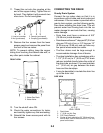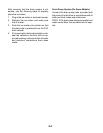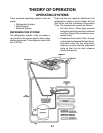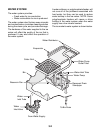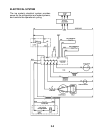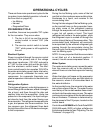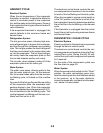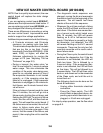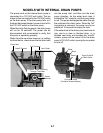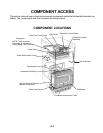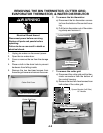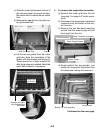3-4
OPERATIONAL CYCLES
There are three main operational cycles for the
ice maker (more detailed operation is found in
the flow chart on page 6-5):
• Ice Making
• Harvest
• Diagnostics/Clean
ICE MAKING CYCLE
In addition, there are two possible “Off” cycles
for the ice maker. They occur when:
1. The bin is full of ice and the service
control switch is turned “ON” (Idle
mode).
2. The service control switch is turned
“OFF” while power is still supplied to
the unit.
Electrical System
Power is supplied through the service control
switches to the primary side of the voltage
step-down transformer, (120 VAC reduced to
8.7 VAC for the cutter grid and the bin light),
and the electronic control board. The elec-
tronic control board in turn supplies 120 VAC to
the water recirculating pump, water inlet valve,
hot gas solenoid, condenser fan motor, and
compressor. An evaporator thermistor sup-
plies temperature information to the electronic
control.
Refrigeration System
The hot gas refrigerant, under high pressure, is
forced through the condenser, where it changes
into a liquid, and flows through the drier and
capillary tube into the evaporator. Under low
pressure in the evaporator, the liquid refriger-
ant absorbs heat from the water flowing over
the evaporator. The refrigerant evaporates into
a gas, and passes into the accumulator. As a
low pressure gas, the refrigerant flows back
through the suction line of the heat exchanger,
to the compressor.
During the Ice Making cycle, some of the hot
gas that is in the condenser accumulating tube,
condenses to a liquid, and remains in the
accumulating tube.
During the later stages of the Ice Making cycle,
as the ice slab forms on the evaporator freez-
ing plate, some of the refrigerant passing
through the evaporator will not evaporate into
a gas, but will remain a liquid. This liquid
refrigerant will settle in the accumulator, while
the refrigerant vapor is sucked off through the
suction tube at the top of the accumulator. This
accumulated liquid refrigerant will eventually
be evaporated by the warmed refrigerant gas
passing through the accumulator during the
Harvest cycle, and during the beginning of the
next Ice Making cycle.
NOTE: It is very important that the accumulator
is not tilted out of a horizontal position. If
moved, it could cause compressor failure.
Water System
The water recirculating pump moves the water
from the reservoir pan up to the distributor,
where it flows out over the evaporator freezing
plate.
Water that does not freeze on the evaporator
plate runs off the front edge, and falls back into
the reservoir, where it is recirculated back to
the water distributor.
As the ice slab forms, the minerals in the water
are on the surface of the ice. The water flowing
over the top of the ice slab washes these miner-
als back into the water reservoir pan. The water
continues to recirculate until the ice slab reaches
the set thickness. Thickness is determined by
the placement of the P4 jumper, located on the
control board.
Control board #6100499 with Code Date MGR/
0245 (45th week, 2002), or higher, will allow ice
thickness adjustments (see “Adjusting The Ice
Thickness” on page 8-3).




